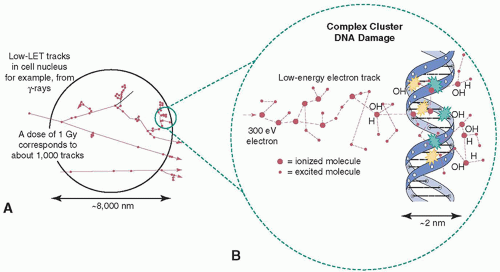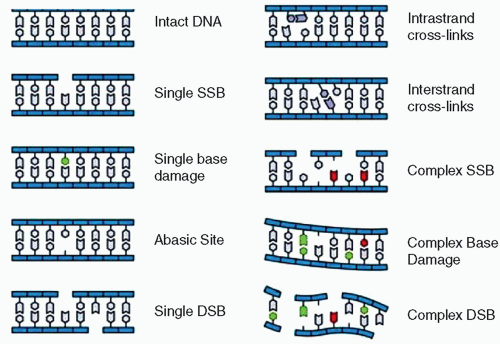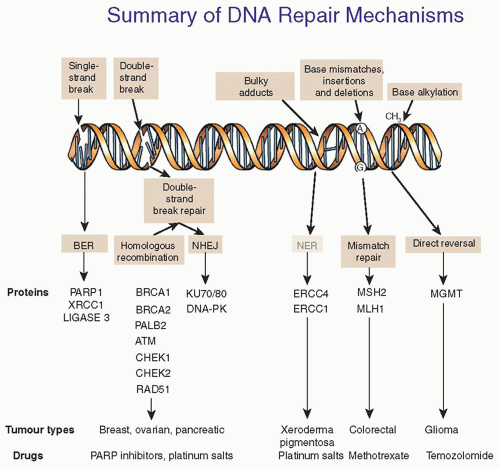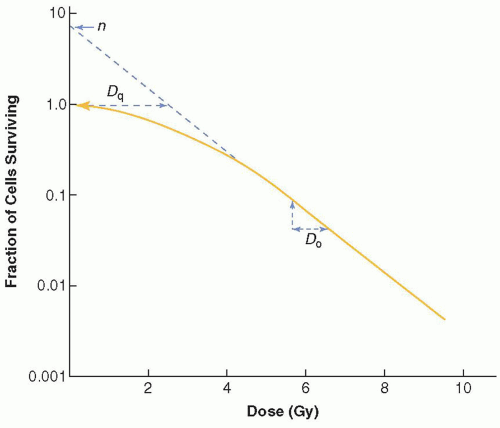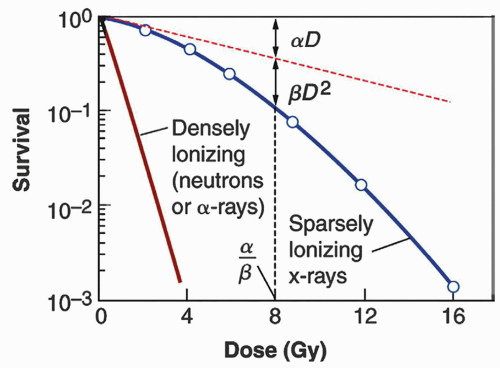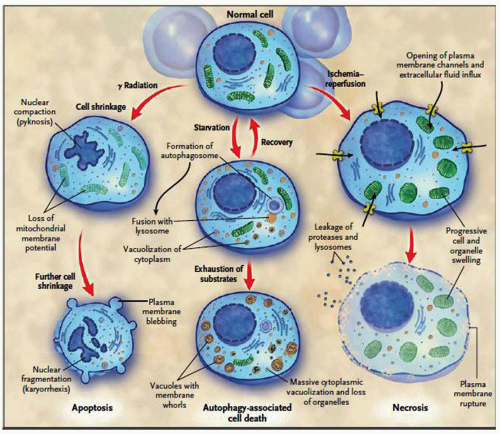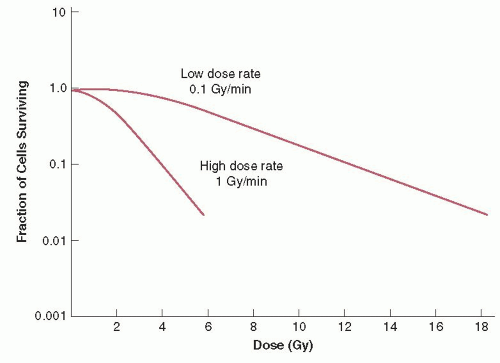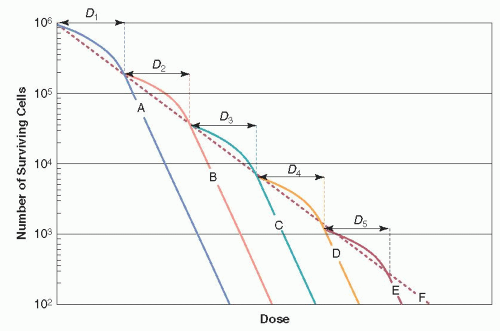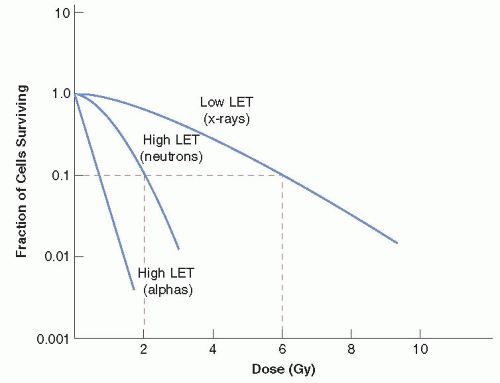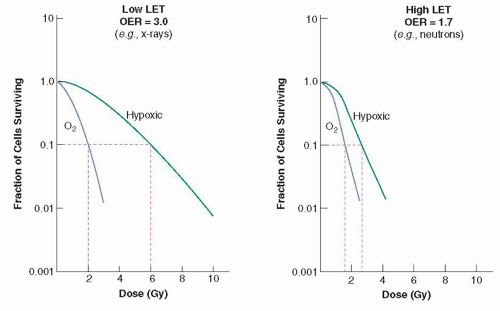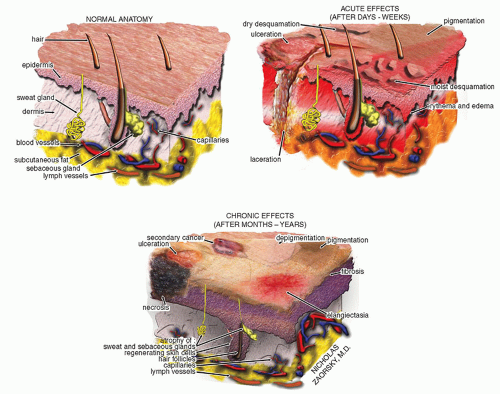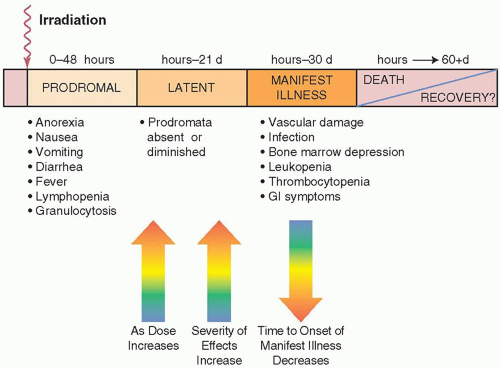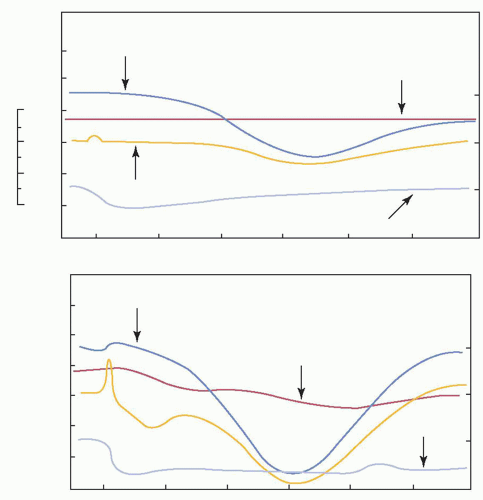1. Stochastic effects: the probability of effect, not severity, increases with dose. Examples include cancer and inherited effects. This leads to the model that risk, for example, of cancer, increases with dose and there is no threshold below which the magnitude of risk goes to zero.
2. Tissue reactions (previously called deterministic effects): above a dose threshold, the severity of injury increases with dose, and, in some tissues, the predominant effect is a result of cell killing. Examples of tissue reactions include skin erythema, fibrosis, and hematopoietic damage.
1. Radiation interactions in cells and tissues can produce changes either directly or indirectly.
a. Direct action occurs if a biologic macromolecule such as DNA is ionized or excited by an ionizing particle or photon passing through or near it.
b. Because cells and tissues are about 70% water, most ionizing radiation interactions will be with water molecules, resulting in production of water-derived free radicals that in turn interact with critical biomolecules like DNA to cause damage, the indirect action (Fig. 20-1).
c. Free radicals are atomic or molecular species that have unpaired orbital electrons and are highly reactive.
d. The majority of biologically important indirect effects from low-LET radiation are due to reactions of the hydroxyl radical (·OH) with DNA.
e. The damaging effect of free radicals is enhanced by the presence of oxygen. Oxygen combines with the hydrogen radical to form a highly reactive oxygen species (ROS) such as the hydroperoxyl radical or by reaction with organic radicals, for example, produced on DNA, to form peroxyradicals which are more difficult for a cell to repair.
2. The biological effects of radiation generally increase with increasing LET because the higher specific ionization produces a greater number and more complex clustered DNA damages (Fig. 20-1). The greater effect is quantified using relative biological effectiveness, RBE, the ratio of the dose of a reference radiation (usually 250 kV X-rays) to the dose of the high-LET radiation that gives the same level of biological damage.
a. RBE tends to increase with LET to a maximum at an LET of about 100 keV/µm, then decrease at high LET values.
b. Although RBE values depend on many factors such as biological system and endpoint, dose, dose rate, and fractionation, they are important for setting radiation weighting factors, wR.
1. Ionizing radiation produces a number of types of DNA damages (Fig. 20-2). For mammalian cells, an absorbed dose of 1 Gy from x-rays will produce approximately 40 DSBs, 1,000 SSBs, and 3,000 damaged bases per cell.
2. Regardless of its severity or consequences, the loss or change of a base is considered a type of mutation.
3. Chromosome breaks produced by radiation can result in chromosome aberrations, which can be observed in cells microscopically during anaphase and metaphase, when the chromosomes are condensed.
4. The DNA damage response (DDR) in cells may include activation of cell cycle checkpoints whereby cell cycle progression is arrested to allow for repair of damaged DNA or incompletely replicated chromosomes or initiation of cell death pathways if the damage is too severe.
a. Most of these DNA repair processes occur rapidly (complete within an hour).
b. Base excision repair (BER), nucleotide excision repair (NER), mismatch repair (MMR), and homologous recombination repair (HRR) are generally highly accurate, although nonhomologous end joining (NHEJ) is error-prone (Fig. 20-3).
c. Defects in the HRR and NHEJ pathways for repair of DSBs can result in increased radiation sensitivity of cells or even in humans who harbor those defective genes.
d. Types of chromosome aberrations produced by ionizing radiation include fragments, rings, translocations, and dicentrics. Measuring chromosome aberrations in human lymphocytes using fluorescence in situ hybridization (FISH) is a potential way to assess radiation exposure. For actively proliferating cells, a widely used approach to assess radiation response is the colony formation assay, which assesses the ability of a cell to proliferate indefinitely. Cell survival curves, which reflect the relative radiosensitivity of cells, are generally presented as radiation dose plotted on a linear scale on the x-axis and the surviving fraction (SF) from clonogenic assay on a logarithmic scale on the y-axis. Several mathematical models can be used to describe the survival curves, the two most commonly used being the multitarget (or n–D0) model (Fig. 20-4) and the linear-quadratic (LQ) model (Fig. 20-5).
5. Loss of proliferative capacity in irradiated cells can be due to processes such as senescence, quiescence, or terminal differentiation, or because of cell death modes including mitotic catastrophe, apoptosis (Fig. 20-6), autophagy, necroptosis, or necrosis. Most radiation-induced death in proliferating cells results from mitotic death/catastrophe that occurs when cells cannot go through mitosis, generally because of chromosome damage. Nonproliferating cells may be lost through the regulated processes of apoptosis, autophagy or necroptosis, or unregulated necrosis. Each of those processes involves characteristic morphological cell changes and distinct cascades of molecular events.
a. During apoptosis, cells show shrinkage, nuclear condensation, and extensive membrane blebbing, ultimately resulting in cell fragmentation into membrane-bound apoptotic bodies that are eliminated by phagocytosis without causing inflammation. Molecular hallmarks of apoptosis include sequential activation of caspases; interactions of pro- and antiapoptotic members of the Bcl-2 family of proteins, many at the mitochondria; cleavage of multiple proteins; and, ultimately, internucleosomal DNA cleavage. Radiation can induce apoptosis through DNA damage initiating transcription of proapoptotic proteins that activate intrinsic apoptosis or up-regulation of death receptors to initiate extrinsic apoptosis pathways. b. Autophagy is a process of “self-digestion” of cellular components that can be initiated to obtain energy in cells starved of nutrients or to remove damaged molecules and components, promoting cell survival. It also can be activated by genotoxic stress, such as radiation-induced DNA damage, and if the cell damage is extensive, lead to cell death with characteristic morphology and protein cascades.
6. Radiation response can be influenced by conditional factors such as dose rate, LET, and the presence of oxygen, as well as by inherent biologic factors that are characteristic of the cells themselves, such as mitotic rate, degree of differentiation, and stage of the cell cycle.
a. The rate at which low-LET radiation is delivered affects the degree of biologic damage (Fig. 20-7). In general, high dose rates are more effective at producing biologic damage than low dose rates, presumably because there is more time to repair sublethal damage when the dose is delivered slowly over time.
b. In a similar fashion, if a radiation dose is fractionated into two or more doses with time in between, sublethal damage can be repaired between the fractions, resulting in decreased damage (Fig. 20-8). This concept is fundamental to radiation therapy where, traditionally, dose has been fractionated into multiple daily doses, which “spares” normal tissues, especially late responding normal tissues, relative to tumors.
c. High-LET radiation is considerably more effective in producing cell damage than low-LET radiation (Fig. 20-9) because the dense ionization tracks typically produce more complex, clustered DNA damage that cannot be repaired accurately (Fig. 20-1). Because the complex damage is difficult to repair, there is also a decrease in the dose rate effect as LET increases.
d. Under hypoxic conditions, the level of damage caused by low-LET radiation is decreased, relative to the damage when cells are irradiated in the presence of oxygen (Fig. 20-10). The difference is quantified using the oxygen enhancement ratio (OER), defined as the radiation dose that produces a given biologic response in the absence of oxygen divided by the dose that produces the same biologic response in the presence of oxygen. The OER in well-aerated cells and tissues is 2.5 to 3 with low-LET radiation but decreases to 1.0 (i.e., no oxygen effect) with high-LET radiation. The radiation resistance of hypoxic cells can be important in radiation therapy because some human tumors contain hypoxic regions.
7. With a few exceptions (e.g., lymphocytes), radiosensitivity is greatest for cells that (1) have a high mitotic rate, (2) have a long mitotic future, and (3) are undifferentiated. For example, bone marrow stem/early progenitor cells are extremely radiosensitive, whereas the fixed postmitotic cells that comprise the central nervous system are relatively radioresistant.
a. In general, cells exposed to low-LET radiation are most sensitive during mitosis (M phase) and the “gap” between S phase and mitosis (G2), less sensitive during the preparatory period for DNA synthesis (G1), and least sensitive during late DNA synthesis (S phase). The sensitivity differences largely reflect differences in cellular repair ability during the different cell cycle phases.
b. Radiation also can alter the function of proteins involved in cell cycle checkpoints. Of particular note, radiation can cause cell cycle arrest in proliferating cells in the G1 and G2 phases, with G1 arrest dependent on cells having a wild-type TP53 tumor suppressor gene, producing the p53 protein that is involved not only in cell cycle arrest but in DNA repair and activating apoptosis in some cell types.
8. A number of phenomena might occur after exposure to low doses of radiation.
a. The adaptive response is seen when a small (e.g., 10 mGy) radiation dose, sometimes called a “priming dose,” decreases the damaging effect of a larger dose (e.g., 2 Gy) given a few hours later.
b. The bystander effect is the observation of changes, for example, DNA damage or altered gene expression, in cells not traversed by radiation when they are in the vicinity of irradiated cells and receive signals from those irradiated cells.
c. Genomic instability is the occurrence of chromosome changes, mutations, delayed lethality, or other alterations in the progeny of cells that were irradiated but did not appear to show these changes.
1. Tissue reactions depend on parenchymal and stem cell killing as well as on complex events including inflammatory, chronic oxidative, and immune reactions, and damage to vasculature and extracellular matrix.
a. In general, early reactions, such as in skin and GI tract, involve killing of the stem/early progenitor cells that supply the mature functional cells in the tissue, as well as inflammatory reactions.
b. Late reactions, for example, in lung, kidney, and brain, involve complex, dynamic interactions among multiple cell types in the tissues and organs and include infiltrating immune cells, production of cytokines, and growth factors, often in persistent, cyclic cascades, and chronic oxidative stress.
2. While radiation-induced skin damage is relatively rare, it is the most commonly encountered tissue reaction following high-dose image-guided interventional procedures. The degree of damage depends on the radiation quantity, quality, and dose rate as well as on the location and size of the irradiated field. Acute effects (days to weeks) can include erythema and edema, moist or dry desquamation or ulceration (after high doses), and changes in pigmentation. Late effects (months to years) include changes in pigmentation, fibrosis, telangiectasia, ulceration, necrosis, and cancer (Fig. 20-11).
3. In general, the gonads are very radiosensitive. Temporary and permanent sterility can occur after acute doses of approximately 500 mGy and 6 Gy, respectively, in the male. In females, the dose that will produce permanent sterility is age-dependent, with higher doses (approximately 10 Gy) required to produce sterility prior to puberty than in premenopausal women over 40 years old (approximately 2 to 3 Gy).
4. The lens of the eye is particularly sensitive to the formation of radiation-induced posterior subcapsular cataracts. Recent epidemiological studies have suggested that the threshold dose for such cataracts is about 0.5 Gy, much lower than had previously been thought. Although the current U.S. regulatory limit is 150 mSv/y to the lens of the eye, the NCRP has recommended that the occupational limit should be 50 mGy/y.
5. Threshold doses and latency periods (time to appearance of damage after irradiation) for normal tissue damage vary substantially with tissue and are dependent on radiation dose and dose rate or fractionation. (Consult Table 20-5 in the textbook.)
1. When the whole body (or a large portion of the body) is exposed to a high acute radiation dose, there are a series of characteristic clinical responses known collectively as the acute radiation syndrome (ARS). In order of occurrence with increasing radiation dose, the ARS includes the hematopoietic, gastrointestinal, and neurovascular syndromes. The clinical manifestation of each subsyndrome occurs in a sequence that includes the prodromal, latent, manifest illness, and, if the dose is not fatal, recovery stages (Fig. 20-12).
a. The prodromal symptoms can include anorexia, nausea, lethargy, fever, vomiting, headache, diarrhea, and altered mental status. The time of onset and severity of prodromal symptoms is dose-dependent with a threshold of about 0.5 to 1.0 Gy. The prodromal symptoms subside during the latent period, the length of which is dose-dependent, and then symptoms of the manifest illness occur.
b. Symptoms of the hematopoietic syndrome include fever, chills, fatigue, and hemorrhages as a result of loss of circulating blood elements due to radiation sterilization of the mitotically active precursor cells (Fig. 20-13). It occurs after acute radiation doses between 0.5 and 10 Gy. Healthy adults with proper medical care almost always recover from doses lower than 2 Gy, whereas doses greater than 8 Gy are almost always fatal unless advanced therapies such as colony-stimulating factors or bone marrow transplantation are successful.
c. In the absence of medical care, the human LD50/60 (the dose that would be expected to kill 50% of an exposed population within 60 days) is approximately 3.5 to 4.5 Gy total body. The LD50/60 may extend to 6 to 7 Gy with supportive care such as transfusions and antibiotics and may be as high as 8 Gy with hematopoietic growth factors in an intensive care setting.
d. At doses greater than 12 Gy, the gastrointestinal syndrome becomes prominent and is primarily responsible for lethality. The symptoms of malnutrition, vomiting and diarrhea, anemia, sepsis, dehydration, and acute renal failure from fluid and electrolyte imbalance, reflect the denudation of the mucosal lining of the GI tract due to the loss of reproductive capacity of the intestinal crypt stem cells. These changes in the GI tract are compounded by equally drastic changes in the bone marrow, although those have not reached peak effect in the circulating bloodstream. Death is essentially 100% and occurs within 3 to 10 days after the exposure if no medical care is given or as long as 2 weeks afterward with intensive medical support.
e. Death from the neurovascular syndrome (also called cerebrovascular syndrome) occurs within 2 to 3 days after doses in excess of 50 Gy. Death is caused by cardiovascular shock, massive edema, increased intracranial pressure, and cerebral anoxia, in part caused by severe damage to the microvasculature.
f. The clinical features of the manifest illness phase of ARS are summarized in Table 20-1.
| ||||||||||||||||||||||||||||||||||||||||||||||||||||||||||||||||||
1. Cancer is the most important delayed somatic effect of radiation exposure. However, radiation is a relatively weak carcinogen at low doses (e.g., occupational and diagnostic exposures), and significantly increased cancer risks cannot be detected at the doses typically encountered in diagnostic imaging.
a. Baseline cancer rates must be kept in mind when evaluating radiation-induced cancer rates. The baseline annual cancer incidence and mortality age-adjusted rates, for the U.S. population, are approximately 436 and 156 per 100,000, respectively, with males having a higher incidence rate (471 per 100,000) than females (413 per 100,000).
2. Cancer arises from abnormal cell division, with cells in a tumor thought to descend from a common ancestral cell that at some point lost control over normal reproduction.
a. Two classes of genes, tumor suppressor genes, for example, TP53, and oncogenes, for example, the RAS family, which respectively inhibit and encourage cell growth, play major roles in triggering cancer.
b. In a simplified fashion, cancer formation has been thought of as developing in three stages: (1) initiation due to damage in a single cell resulting in a preneoplastic stage followed by (2) promotion which permits the cell to successfully proliferate then (3) progression during which the transformed cell produces phenotypic clones of which one acquires the advantage of evading the host’s defense mechanisms, thus allowing tumor development.
c. It is now recognized that as cells evolve to a neoplasm, they acquire a succession of capabilities that enable them to become tumorigenic and ultimately malignant. Hanahan and Weinberg originally described six “Hallmarks of Cancer”—sustaining proliferative signaling, evading growth suppressors, resisting cell death, enabling replicative immortality, inducing angiogenesis, and activating invasion and metastasis—and more recently have enumerated two enabling characteristics—genome instability and inflammation—and two emerging hallmarks—energy metabolism and evading immune destruction (Fig. 20-14A).
d. Furthermore, tumors are complex tissues, composed of multiple interacting cell types including stromal cells, such as fibroblasts, and the endothelial cells and pericytes of the vasculature, as well as immune inflammatory cells (Fig. 20-14B). Together, these various cell types create a tumor microenvironment that is critical for cancer development and can influence tumor response to treatments, including radiation.
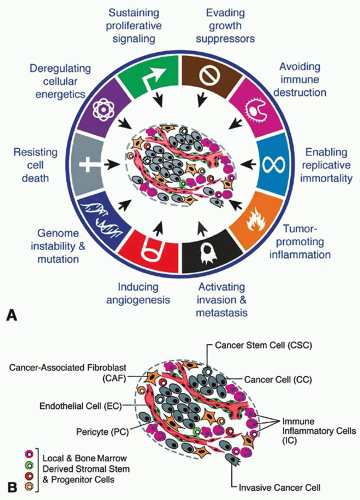
▪ FIGURE 20-14 The “Hallmarks of Cancer.” A. This illustration depicts the original six “Hallmarks of Cancer” described in 2000 by Hanahan and Weinberg as well as the two emerging hallmarks (deregulating cellular energetics and avoiding immune destruction) and enabling characteristics (genome instability and mutation and tumor-promoting inflammation) they added subsequently. Radiation could play a role in many or all of these processes involved in carcinogenesis. B. In addition to the cancer cells, a tumor is composed of multiple cell types that interact to produce the tumor microenvironment that has a critical role in cancer development as well as response to treatments, including radiation. F. 20-27
F. 20-27
Stay updated, free articles. Join our Telegram channel

Full access? Get Clinical Tree

 Get Clinical Tree app for offline access
Get Clinical Tree app for offline access

